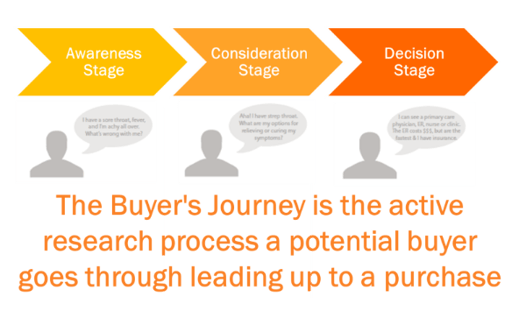The goal of any marketing strategy is to convert a lead into a sale. Understanding the Buyer's Journey is the key to success in that strategy.
The Buyer's Journey is the process a consumer maneuvers through before purchasing a product or service. While the process may differ based on the industry, products or services, the basis of the journey is the same.
Typically, there are five main stages of the Buyer's Journey, which is commonly visualized as a funnel.
Each buyer's journey can be further simplified into just three stages:
- Awareness
- Consideration
- Conversion
The key to success is identifying where in the stage each consumer is and providing them with the necessary information, influence, or tools to complete the process.
Marketers must base their purchaser's journey on research, a strategy based on inbound marketing, which we discussed in an earlier blog post.
Simplifying the Buyer's Journey into three stages allows the marketer to adapt the strategy to each customer based on the stage.
It all starts with awareness, which is the customer being generally knowledgeable about the company. This could be awareness based on catchy TV commercials, radio spots, website ads or even social media posts.
That awareness leads to the consideration stage. It's at this point, the consumer researches the company's products or services and evaluates how they meet the individual needs of the consumer.
Finally, the conversion stage consists of the consumer taking action, hopefully, that results in a purchase.
Further breaking the Buyer's Journey down into five stages allows for a more precise strategy to funnel the consumer into a purchase.
Again, the five-stage Buyer's Journey begins with awareness, but in this deep-dive it ends with retention.
The five stages are:
- Awareness
- Interest
- Consideration
- Conversion
- Retention
Learning more about each stage is essential for the marketing professional.
Starting with the first stage, Awareness, the marketer must understand the consumer is early in the process of a purchase. While each consumer is different, this stage typically includes the identification of a need or problem that must be solved. That leads the consumer to search for a solution such as the products or brands that can fill the need and this is where the marketer should introduce the brand/company as the solution.
The Interest stage leads the consumers to the products/services that can address their needs. At this point, the consumer has an idea of what products/services could resolve their need but more information is necessary before a decision is rendered. This stage includes searching product reviews, website reviews, blog articles and social media to learn more about each product/service.
In the Consideration stage, the consumer is aware of the brand options and has a good idea of which product/service will meet the needs. Inbound strategies are especially effective in this stage as that strategy effectively targets the consumer and the relative need.
Moving on, the Conversion stage represents the moment the consumer is ready to take action. The research has been completed and the consumer has identified the product/solution that best resolves the problem/needs. All that's left is for the marketer to provide a point of contact for the consumer to close the sale. This is achieved through targeting and re-targeting, offers and creating a sense of urgency, such as an offer that expires within a set amount of time.
Following the conversion, the Retention stage is key to ensure reoccurring revenue and to create a group of brand advocates. Satisfied customers lead to more sales and positive reviews, which drive further sales. In the Retention stage, marketers work to keep converted customers happy and to create brand loyalty.

No comments:
Post a Comment